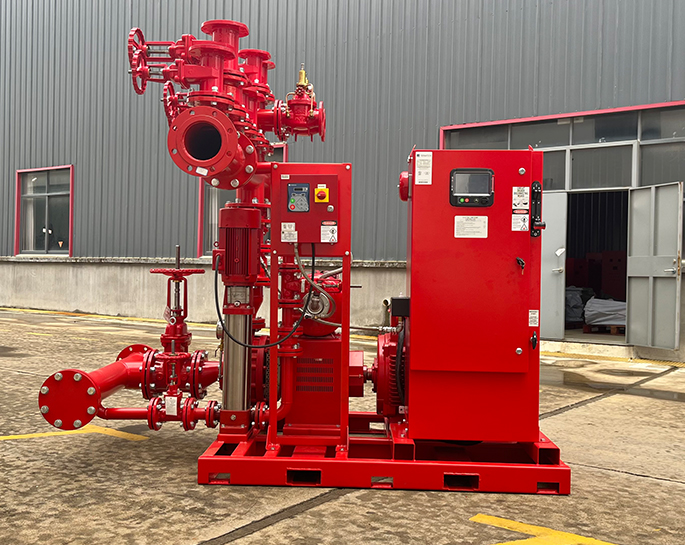How do you prevent cavitation in a fire pump system?
Dec 26, 2023
Share:
Cavitation in a fire pump system can lead to significant damage and reduced pump performance. Cavitation occurs when the pressure of the liquid drops below its vapor pressure, causing the formation of vapor bubbles. When these bubbles collapse, they create shock waves that can erode pump components and reduce efficiency. To prevent cavitation in a fire pump system, consider the following measures:
1. **Proper Pump Sizing:**
Ensure that the fire pump is correctly sized for the system requirements. Undersized pumps are more prone to cavitation because they may struggle to meet the demand, leading to low pressures in the system.
2. **Adequate NPSHA (Net Positive Suction Head Available):**
NPSHA is the difference between the suction pressure and the vapor pressure of the fluid. Ensure that the NPSHA is greater than the NPSHR (Net Positive Suction Head Required) for the pump. This ensures that the pump has enough suction pressure to prevent cavitation.
3. **Correct Impeller Selection:**
Choose the right impeller for the pump based on the system requirements. Proper impeller selection is crucial for maintaining a smooth flow of fluid through the pump and minimizing the risk of cavitation.
4. **Suction Piping Design:**
Ensure that the suction piping is designed to minimize friction losses and restrictions. Adequate pipe diameter, straight runs of piping, and avoiding sharp bends contribute to maintaining proper flow and preventing cavitation.
5. **Proper Suction Lift:**
Minimize the suction lift (vertical distance from the water source to the pump) to reduce the risk of cavitation. If a suction lift is necessary, consider using a foot valve or a flooded suction arrangement to maintain a continuous flow to the pump.
6. **Avoid Air Entrapment:**
Ensure that the pump is properly primed to avoid air entrainment, which can contribute to cavitation. Proper venting and bleeding of air from the system are essential.
7. **Regular Maintenance:**
Conduct regular inspections and maintenance of the pump system. Check for wear and tear on impellers, valves, and other components. Replace any damaged parts promptly to prevent conditions that may lead to cavitation.
8. **Pressure Relief Valve:**
Install a pressure relief valve in the system to prevent excessive pressure that could lead to cavitation. This valve helps protect the pump from operating outside its design limits.
9. **Monitor Pump Performance:**
Implement a monitoring system to regularly check pump performance and identify any anomalies. Monitoring can include measuring pressures, flow rates, and other relevant parameters.
By implementing these measures, you can significantly reduce the risk of cavitation in a fire pump system and ensure the reliable operation of the system in emergency situations. Always consult with pump manufacturers and follow their guidelines for proper installation, operation, and maintenance.

1. **Proper Pump Sizing:**
Ensure that the fire pump is correctly sized for the system requirements. Undersized pumps are more prone to cavitation because they may struggle to meet the demand, leading to low pressures in the system.
2. **Adequate NPSHA (Net Positive Suction Head Available):**
NPSHA is the difference between the suction pressure and the vapor pressure of the fluid. Ensure that the NPSHA is greater than the NPSHR (Net Positive Suction Head Required) for the pump. This ensures that the pump has enough suction pressure to prevent cavitation.
3. **Correct Impeller Selection:**
Choose the right impeller for the pump based on the system requirements. Proper impeller selection is crucial for maintaining a smooth flow of fluid through the pump and minimizing the risk of cavitation.
4. **Suction Piping Design:**
Ensure that the suction piping is designed to minimize friction losses and restrictions. Adequate pipe diameter, straight runs of piping, and avoiding sharp bends contribute to maintaining proper flow and preventing cavitation.
5. **Proper Suction Lift:**
Minimize the suction lift (vertical distance from the water source to the pump) to reduce the risk of cavitation. If a suction lift is necessary, consider using a foot valve or a flooded suction arrangement to maintain a continuous flow to the pump.
6. **Avoid Air Entrapment:**
Ensure that the pump is properly primed to avoid air entrainment, which can contribute to cavitation. Proper venting and bleeding of air from the system are essential.
7. **Regular Maintenance:**
Conduct regular inspections and maintenance of the pump system. Check for wear and tear on impellers, valves, and other components. Replace any damaged parts promptly to prevent conditions that may lead to cavitation.
8. **Pressure Relief Valve:**
Install a pressure relief valve in the system to prevent excessive pressure that could lead to cavitation. This valve helps protect the pump from operating outside its design limits.
9. **Monitor Pump Performance:**
Implement a monitoring system to regularly check pump performance and identify any anomalies. Monitoring can include measuring pressures, flow rates, and other relevant parameters.
By implementing these measures, you can significantly reduce the risk of cavitation in a fire pump system and ensure the reliable operation of the system in emergency situations. Always consult with pump manufacturers and follow their guidelines for proper installation, operation, and maintenance.


.png)
.png)

.png)


